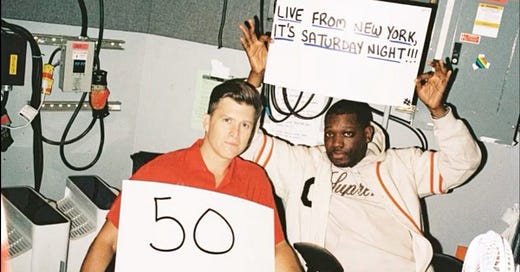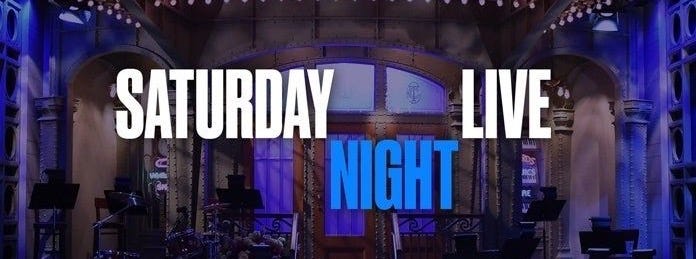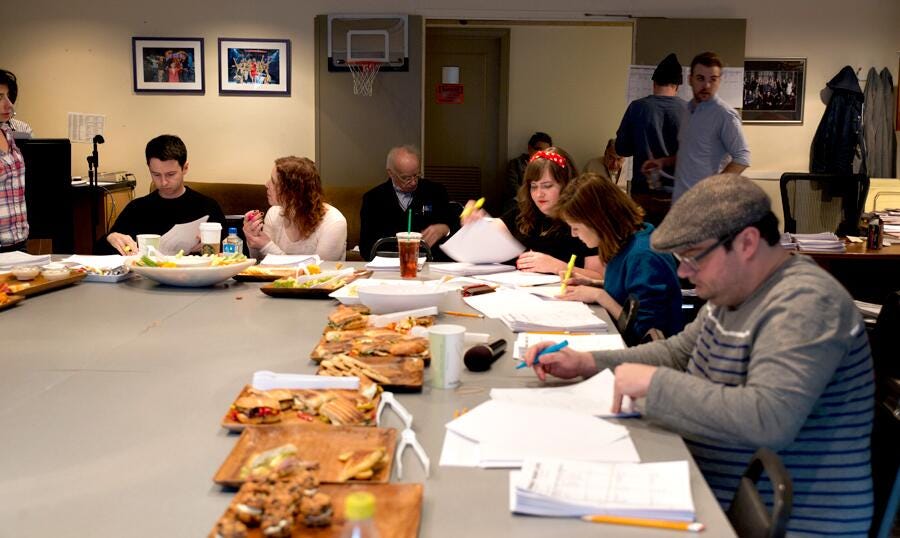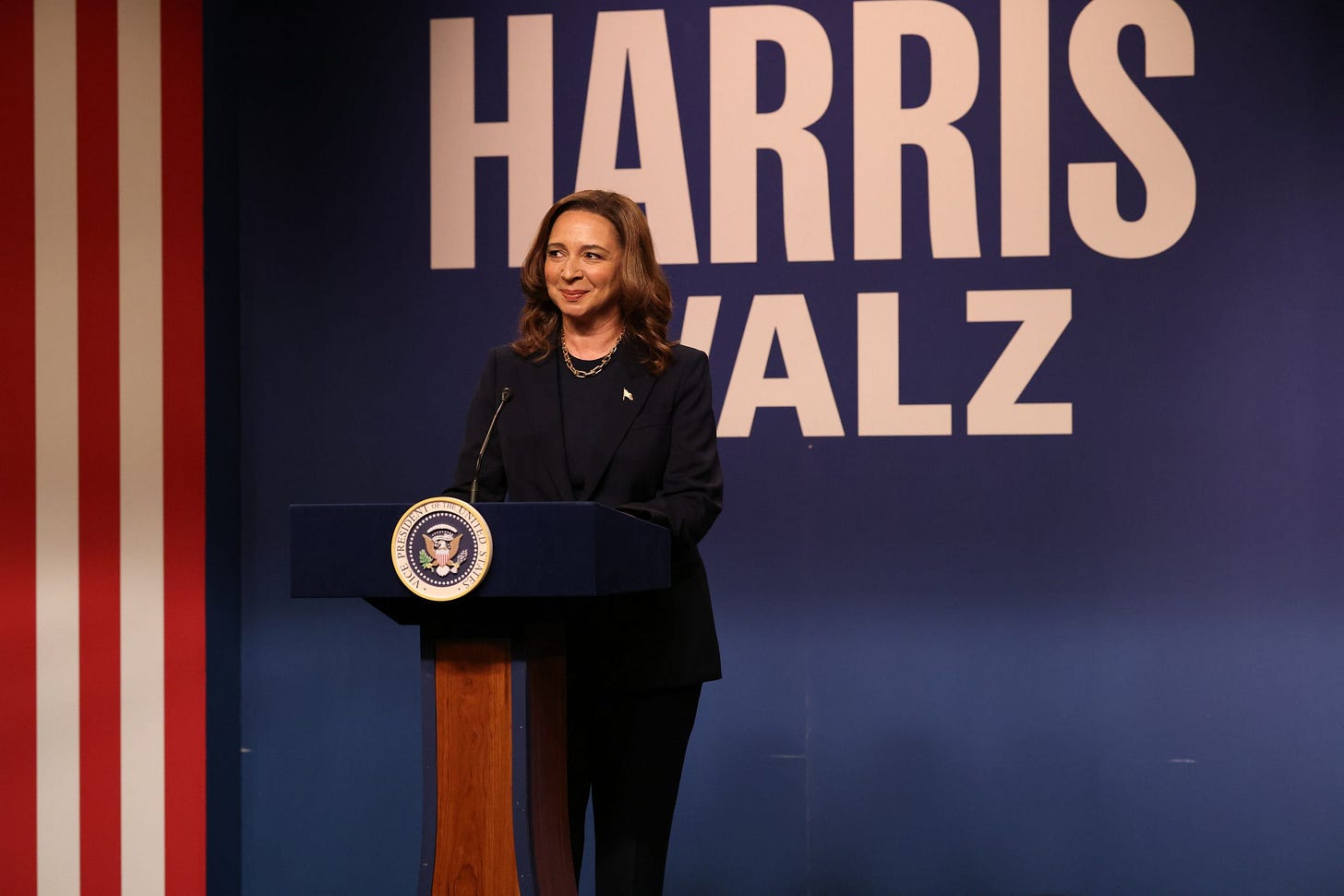As the 50th season of SNL wrapped up, I felt a particular stillness that follows the end of a Saturday Night Live cold open, applause fading, live camera drifting, a half-smirk lingering on a cast member's face as the band swells in. For a moment, the illusion holds that what we have just seen is rebellious, vital, and corrective. A parody sharp enough to puncture the week's absurdities every week, and yet, as the monologue begins and the familiar scaffolding of the show clicks into place, something else sets in - a faint, unplaceable hollowness like déjà vu delivered through cue cards.
SNL is less a comedy show at fifty seasons than an American rite. It recurs with the reliability of Sunday mass or state funerals, built on the same bones: impersonation, exaggeration, catharsis but within that ritual lies a contradiction. The show gestures at satire but often stops short of disruption. It performs dissent without quite embodying it, holding a mirror to power only to smoothen its reflection. Today, I ask what it means when satire becomes institutional. What happens when the act of laughing at the system becomes part of the system itself? Not so Live from Substack, It's about….
At its best, Satire sits at the uneasy intersection of critique and complicity. As Lauren Feldman argues, it "both reinforces and resists hegemonic meanings," a duality that gives it cultural traction and sometimes a numbing ambiguity. Similarly, Jeffrey Jones warns that satire risks becoming "a release valve" rather than a provocation, a way to laugh at the dysfunction without demanding its dismantling. These tensions are not abstract. Televised every Saturday night, where SNL navigates and often blurs the line between comic relief and cultural commentary.
Few institutions have shaped political memory quite like Saturday Night Live. Before memes became the dominant medium of political interpretation, SNL distilled politicians into digestible absurdities. From as early as Chevy Chase's President Ford to the recent Maya Rudolph's Kamala Harris portrayed with calculated cadence, knowing laughter, and mock-presidential warmth, became a version of the former Vice President more charismatic than her real-life counterpart. With his pout and squint and stiff-fingered gestures, James Austin Johnson's Trump came to embody the first convict president for a generation of viewers who might have otherwise disengaged. Still, this translation from a political figure to a sketch character is not neutral.
At what point does parody cease to critique and begin to endear?
To laugh at Harris' syntax or Trump's absurdity is not to reckon with their policies or consequences. Repeated mimicry risks softening their edges i.e flattening danger into farce. It creates a kind of aesthetic safety, these figures become familiar, even charming in their ridiculousness. We mimic the mimicry, quote the punchlines, replay the skits and, in doing so, internalise a performance, not a critique. If satire is meant to provoke, SNL often diffuses.
It is here that the show's institutional longevity becomes a liability. The machinery of weekly satire demands caricature more than confrontation. What results is less a lampooning of power than a rendering of it in costume? Amusing, yes, but perhaps too gentle for our times.
For all its posturing as irreverent, Saturday Night Live runs like clockwork. The cold open, the monologue, Weekend Update, the musical guest. The structure rarely deviates. What began as live-wire improvisation has ossified into format. Where even the act of rebellion arrives on cue. The 2020 election brought in Jim Carrey as Joe Biden, a casting choice that generated buzz but confusion. Carrey's manic energy, recycled catchphrases, and Ace Ventura callbacks clashed with Biden's slow, measured demeanour. The impersonation wasn't just off… it was oddly reverential. Sketches avoided Biden's centrist politics or legislative compromises, instead framing him as a cool-headed saviour. After the election was called and results were out, Carrey's Biden announced Trump was a "loooooser," quoting Ace Ventura. It was more catharsis than satire, a purge of tension for viewers, not an interrogation of the moment. A chillax show for viewers, not a confrontation with the incoming administration
Maya Rudolph's portrayal of Kamala Harris is another case in point. The satin pantsuits, the knowing smirk, the exaggerated finger guns, Its warm, charismatic, almost regal. Rudolph plays Harris not as a politician but as the cool aunt at the barbecue. It's funny, yes, but also frictionless. The performance smooths over contradictions and sidesteps critique. There's no real engagement with Harris's political record, just a glow-up a little flair and likability. The vice presidency was repackaged for prime time.
It is the cost of becoming a cultural institution. SNL is no longer an insurgent voice, it is legacy media, a fixture of NBC's brand ecosystem. Its corporate dependencies dilute its punch. Sketches are vetted, not for sharpness but for shareability. The show has mastered the aesthetics of dissent without the consequences. What we get isn't rupture — it's strategic. Safe, marketable satire. Critique that doesn't unsettle or discomforts.
It's not just about repetition; it's about choreography. Satire is pre-scheduled, buffered by ad breaks and audience applause. The political becomes performance, and the ‘critique’ becomes content. SNL doesn't dismantle power so much as rehearse its absurdities, again and again, until they become background noise. There's catharsis in laughter, but catharsis is not change.
The problem isn't that SNL mocks power. It's that it makes power entertaining, palatable, and familiar. In doing so, it risks anaesthetising us to the systems it claims to lampoon. The problem, of course, extends beyond Saturday Night Live. Satire itself is in flux—or perhaps in decline. What once served as an insurgent language of dissent now risks becoming just another dialect of entertainment. The line between critique and content blurs, and satire loses its teeth in that blurring.
Much modern satire doesn't seek to provoke discomfort but to affirm what the audience already knows or worse, what they already like. It flatters its viewers into thinking they are in on the joke when it is often toothless. The targets are apparent, the punchlines recycled, and the politics of it all safely contained within algorithm-friendly formats. Satire has been optimised. It is timely but rarely timeless. Fast but not deep. If SNL's satire is polished into smooth predictability, then its sharper cousins now thrive where chaos rules — online.
American comic Sarah Cooper lip-synced Trump's absurdities word-for-word on TikTok, exposing their derangement by simply not editing them. The American Political Comic Duo, The Good Liars crash political rallies to troll GOP figures in real time, their satire filmed on smartphones, not soundstages. Using face-swap tech, Kyle Dunnigan unleashes parodic Bidens and Cuomos far too unfiltered for NBC's censors. Their work is nimble, messy, and direct — satire by confrontation, not cue card.
Even legacy satire outlets like The Onion retain bite in ways SNL doesn't. The fringe from leftist meme accounts to right-wing satire sites like Babylon Bee is willing to risk offence, absurdity, or cancellation. The result is a fragmented but furious landscape of comedy that doesn't wait for permission. It's unscheduled, unvetted, sometimes ugly, and often sharp.
There is an implicit bargain here tho, We'll laugh at the absurdity of our world, but only if the laughter is clean, marketable, and doesn't threaten the structure that sustains it. SNL exemplifies this pact by serving us a show that performs transgression without ever crossing the line. Because the line, after all, is drawn by the same institutions that bankroll the production (looks at you NBC). When Lorne Michaels explicitly asked writers not to vilify Trump in 2015, he wasn't just preserving ratings; he was upholding precisely this unspoken agreement, reminding us that even our satire has boundaries set by corporate comfort.
So, we are left with a genre that once demanded attention and is now begging for viralality. It is not satire that challenges power but satire that consolidates it by making it feel familiar, even funny. The joke isn't just on the politicians anymore—it's on us for thinking that laughter alone can count as resistance.
To declare Saturday Night Live dead is too easy. Institutions rarely die; they calcify. They adapt just enough to survive. What began as a reckless live wire of counterculture now occupies a comfortable space in the media ecosystem — scheduled, sponsored, safe. Its satire still bears its teeth, but the bite often feels rehearsed. What was once insurgent has become ceremonial.
The implications of this shift are not trivial. When a platform like SNL becomes a fixture of legacy media, it risks converting critique into a necessary tool. Its satire becomes less a medium for disruption than a performance of dissent, folded neatly into the weekend schedule. Power is acknowledged, even impersonated, but rarely unsettled. The audience laughs — not because they are jolted into awareness, but because they already know the script.
This is the danger: that satire, institutionalised, begins to serve the same systems it once skewered. To maintain its edge, satire must resist polish. It must be willing to risk discomfort — not only for its targets but for its audience and itself. Moments of genuine rupture often come from what cannot be fully scripted: an unsanctioned monologue, a sketch that stumbles into sincerity, a line that cuts too close. And yet, before we turn away from Studio 8H entirely, it's worth noting that even the machine occasionally malfunctions and something authentic slips through. In 2021, Cecily Strong appeared on Weekend Update as "Goober the Clown," speaking — shakily, satirically — about her abortion. Between balloon animals and squirting flowers, Strong delivered real testimony: "I had an abortion when I was 23. It's my clown business." The sketch was messy, funny, and deeply sincere. A rare moment when the joke strained to carry truth. It broke character and convention, pushing viewers past comfort.
Another rare break came after the 2016 election, when Kate McKinnon, in her Hillary Clinton persona, opened the show not with a sketch but with a solo piano rendition of Leonard Cohen's "Hallelujah." McKinnon's performance was sombre, reverent, and unsatirical — a eulogy not just for Clinton's campaign but for a shared sense of political normalcy. "I'm not giving up, and neither should you," she said directly into the camera. For some, it was moving; for others, it was tonal whiplash a comedy show caught in ceremonial grief. Either way, it revealed how SNL sometimes exchanges critique for catharsis.
Dave Chappelle's guest monologues offer another kind of rupture, raw, unscripted reflection. In his 2016, 2020 and even 2025, Chappelle stepped onstage in a quiet suit and lit a cigarette, speaking with the gravity of someone testifying more than performing.
He veered from jokes into cultural diagnosis, unflinchingly honest about race, addiction, anger, the LA Fires, political unrest in the state, and hypocrisy. It wasn't safe, and it wasn't always comfortable but it cut closer to the truth than many sketches dared. In those moments, SNL didn't feel like network satire, it felt like a mirror, briefly undistorted.
To maintain its edge, satire must resist polish. It must trade safety for friction and unnerve more than it entertains. If all we seek is to laugh at power without feeling implicated, then satire is not resistance… it's relief. This is a challenge SNL once embraced and now only occasionally remembers. At its best, SNL understood this. At its worst, it forgets.
And so it continues, week after week.
Further Reading & Sourves:
Holmes, Helen. “Saturday Night Live is bad, actually.” The Guardian, Feb. 2025. – Analysis of SNL’s legacy and its “soft spot for powerful people”, including examples like Elon Musk’s tame 2021 appearance and SNL’s history of not challenging power.Itkowitz, Colby. Politico Magazine, May 2019. – Why Trump Should Be Thanking Alec Baldwin. Describes how Baldwin’s Trump impression was “tame” and even beneficial to Trump’s image by making him look like a harmless buffoon rather than a threatening figure.Weiss, Sabrina. Entertainment Weekly, Aug. 2023. – Maya Rudolph’s best Kamala Harris moments on SNL. Detailing Rudolph’s portrayal of Harris as the “fun aunt (funt)” and highlighting the comedic focus on Harris’s personality over policy.Rao, Sonia. The Washington Post, Oct. 3, 2021. – Review of SNL’s season premiere cold open on Biden’s infrastructure bill. Notes the introduction of James Austin Johnson’s Biden and the mild jabs at Biden’s rough summer (e.g. “not Cuomo bad, but not Afghanistan good”) – exemplifying moderate critique without real bite.Romano, Aja. “Why Cecily Strong’s ‘clown abortion’ SNL skit is so important.” Vox, Nov. 9, 2021. – Discusses Strong’s “Goober the Clown” segment as “one of the starkest political critiques” in SNL’s recent years and contrasts it with the show’s usual “straightforward… imitations”.Lee, Chris. “Cecily Strong’s clown abortion segment on SNL is no joke.” Los Angeles Times, Nov. 8, 2021. – Provides quotes from Strong’s Weekend Update bit (e.g. “the abortion I had at 23 is my personal clown business”) and describes Jost’s break in character with “You don’t have to do this, Cecily”, highlighting the sketch’s sincerity under the comedy.Holmes, Helen. The Guardian, Feb. 2025. – Cites SNL insiders and critics: e.g. former cast member Taran Killam recalling Lorne Michaels’ instruction not to vilify Trump in 2016; academic Steven Thrasher on SNL’s “no-stance centrism” and liberal complacency. Also mentions SNL allowing Trump to host in 2015, seen as an endorsement.Itkowitz, Colby. Polygon, Nov. 8, 2020. – Recap of SNL’s post-election cold open. Describes how “SNL filled in some blanks” of Biden’s victory speech by having Carrey’s Biden and Rudolph’s Harris openly call Trump a “looo-ser” (Ace Ventura–style) on their behalf – illustrating SNL’s celebratory tone after the 2020 election.Respers France, Lisa. CNN, Oct. 4, 2020. – Coverage of Jim Carrey’s debut as Joe Biden on SNL, noting mixed reactions. (Mentioned for context on Carrey’s energy vs. Biden’s demeanor.)Harmeet Kaur. CNN, Oct. 2020. – Analysis of why Carrey’s Biden didn’t click, quoting viewers saying “the energy is wrong; Biden isn’t manic”.McNamara, Mary. Los Angeles Times, Aug. 1, 2020. – “Sarah Cooper mocks Trump’s proposed TikTok ban”. Profiles Sarah Cooper’s TikTok satire. Quotes Cooper on her mission to highlight Trump’s nonsense: “We’ve been gaslighted… he’s saying ridiculous things… that’s why I wanted to do this”. Also cites L.A. Times theater critic’s praise of Cooper as “a postmodernist with a genius for editing”.Spangler, Todd. Variety, Aug. 2020. – Reports on Sarah Cooper’s viral success and the broader significance of political comedy on TikTok during the election.Wikipedia – The Good Liars: Background on the comedy duo Jason Selvig and Davram Stiefler, confirming their method of “infiltrating conservative rallies… to troll politicians… with many interactions going viral”.Toto, Christian. Hollywood in Toto, May 18, 2025. – “Kyle Dunnigan Mocks Hunter Biden in Hilarious Clip.” Notes that “mainstream comedy… avoids Biden bits”, whereas Dunnigan “in sharp contrast… gleefully hammers Hunter Biden” and riffs on President Biden freely. Criticizes SNL and late-night hosts for not touching certain Democratic targets, highlighting the partisan gaps in mainstream satire that independent creators fill.Schneider, Rob. Interview in The New York Post, 2022. – (Referenced as a cultural note) The former SNL cast member slams the show for the Kate McKinnon “Hallelujah” moment, saying it exemplified SNL “indulging in self-important sentiment” over comedy. (Provides perspective on the mixed reception of SNL’s rare sincere breaks).








